D-Link DIR-645 User Manual
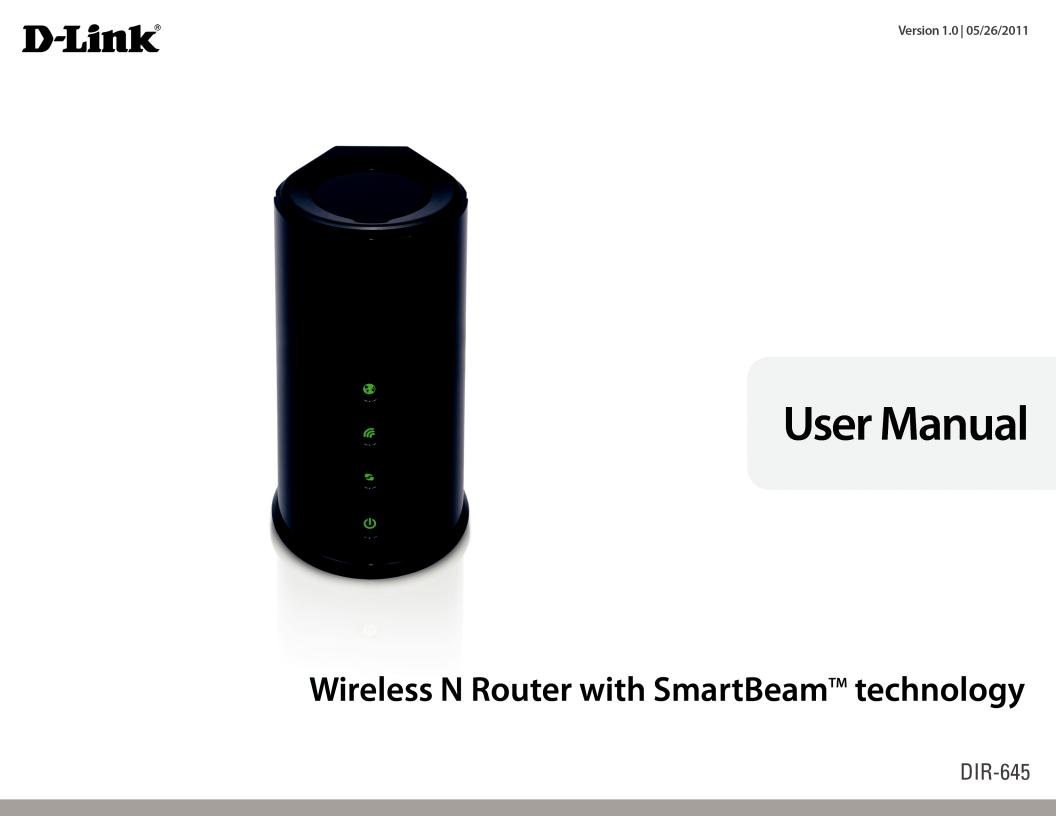

Preface
D-Link reserves the right to revise this publication and to make changes in the content hereof without obligation to notify any person or organization of such revisions or changes.
Manual Revisions
Revision |
Date |
Description |
1.0 |
June 02, 2011 |
DIR-645 Revision A1 with firmware version 1.00 |
|
|
|
Trademarks
D-Link and the D-Link logo are trademarks or registered trademarks of D-Link Corporation or its subsidiaries in the United States or other countries. All other company or product names mentioned herein are trademarks or registered trademarks of their respective companies.
Copyright © 2011 by D-Link Systems, Inc.
All rights reserved.This publication may not be reproduced, in whole or in part, without prior expressed written permission from D-Link Systems, Inc.
D-Link DIR-645 User Manual |
i |

Table of Contents
Preface.................................................................................. |
i |
Manual Revisions................................................................. |
i |
Trademarks....................................................................................... |
i |
Table of Contents................................................................ |
ii |
Product Overview............................................................... |
1 |
Package Contents......................................................................... |
1 |
System Requirements.................................................................. |
2 |
About this Product....................................................................... |
3 |
Features............................................................................................ |
3 |
Hardware Overview...................................................................... |
4 |
Front Panel............................................................................... |
4 |
Back Panel................................................................................ |
5 |
Bottom Panel.......................................................................... |
6 |
Hardware Installation........................................................ |
7 |
Before You Begin........................................................................... |
7 |
Wireless Installation Considerations...................................... |
8 |
Connect to Cable/DSL/Satellite Modem............................... |
9 |
Configuration.................................................................... |
10 |
Web-based Configuration Utility........................................... |
10 |
Setup Wizard................................................................................. |
11 |
Internet Connection...................................................... |
11 |
Internet Connection(Setup Wizard).............................. |
12 |
Manual Configuration........................................................ |
19 |
Wireless Settings.................................................................. |
28 |
Network Settings................................................................. |
36 |
IPv6........................................................................................... |
40 |
Advanced Category.................................................................... |
62 |
Virtual Server........................................................................ |
63 |
Port Forwarding................................................................... |
65 |
Application Rules................................................................ |
66 |
QoS Engine............................................................................ |
67 |
Network Filter....................................................................... |
69 |
Access Control...................................................................... |
70 |
Website Filter........................................................................ |
73 |
Parental Control................................................................... |
74 |
Inbound Filter....................................................................... |
75 |
Firewall Settings................................................................... |
76 |
Routing................................................................................... |
78 |
Advanced Wireless.............................................................. |
79 |
Wi-Fi Protected Setup........................................................ |
80 |
Advanced Network............................................................. |
82 |
DLNA Settings...................................................................... |
84 |
iTunes Server......................................................................... |
85 |
Guest Zone............................................................................ |
86 |
IPv6 Firewall.......................................................................... |
87 |
IPv6 Routing.......................................................................... |
88 |
D-Link DIR-645 User Manual |
ii |

Tools Category............................................................................. |
89 |
Admin...................................................................................... |
90 |
Time.......................................................................................... |
92 |
Syslog....................................................................................... |
93 |
Email Settings....................................................................... |
94 |
System..................................................................................... |
96 |
Firmware................................................................................. |
97 |
Dynamic DNS........................................................................ |
98 |
System Check..................................................................... |
101 |
Schedules............................................................................ |
102 |
Status Category........................................................................ |
103 |
Device Info.......................................................................... |
104 |
Logs....................................................................................... |
106 |
Statistics............................................................................... |
107 |
Internet Sessions.............................................................. |
108 |
Wireless................................................................................ |
108 |
IPv6........................................................................................ |
109 |
IPv6 Routing....................................................................... |
109 |
Support Category.................................................................... |
110 |
Knowledge Base............................................................. |
111 |
Wireless Basics........................................................................... |
111 |
Wireless Modes......................................................................... |
113 |
Wireless Security....................................................................... |
114 |
What is WPA?...................................................................... |
114 |
Networking Basics |
................................................................... |
115 |
Connect to a Wireless Network........................................... |
117 |
|
Using Window |
7................................................................ |
117 |
Using Window |
7 and WPS............................................. |
119 |
Using Window Vista......................................................... |
122 |
|
Using Window XP............................................................. |
124 |
|
Troubleshooting............................................................. |
|
125 |
Technical Specifications................................................. |
127 |
|
D-Link DIR-645 User Manual |
iii |

Section 1 - Product Overview
Product Overview
Package Contents
Check for the supplied accessories below:
DIR-645 Wireless N Router with SmartBeamTM technology
Power Adapter
Ethernet Cable
CD-ROM (with installation software and manuals)
Quick Installation Guide
Note: Using a power supply with a different voltage rating than the one included with the product, will cause damage and void the warranty for this product.
D-Link DIR-645 User Manual |
1 |

Section 1 - Product Overview
System Requirements
Network Requirements |
• An Ethernet-based Cable or DSL modem |
• IEEE 802.11n or 802.11g wireless clients |
|
|
• 10/100/1000 Ethernet |
|
|
|
Computer with the following: |
|
• Windows®, Macintosh, or Linux-based operating system |
|
• An installed Ethernet adapter |
Web-based Configuration |
Browser Requirements: |
• Internet Explorer 6.0 or higher |
|
Utility Requirements |
• Chrome 2.0 or higher |
|
• Firefox 3.0 or higher |
|
• Safari 3.0 or higher (with Java 1.3.1 or higher) |
|
Windows® Users: Make sure you have the latest version of Java |
|
installed. Visit www.java.com to download the latest version. |
|
|
CD Installation Wizard |
Computer with the following: |
• Windows® 7, Vista®, or XP with Service Pack 2 |
|
Requirements |
• An installed Ethernet adapter |
|
• CD-ROM drive |
|
|
D-Link DIR-645 User Manual |
2 |

Section 1 - Product Overview
About this Product
This user’s guide provides a wonderful insight into the functionality of the product called the D-Link DIR-645 Wireless Internet Router. This guide is based on the current running firmware/software version available for this product and might touch on some new and exciting topics never seen on this product line before providing a rewarding reading experience and in the end acts as a guide when installing and maintaining this product.
Features
The D-Link DIR-645 Wireless N Router with SmartBeamTM technology is packed with a load of features. Most of these features are what is expected from an Internet Wireless router, and then there are the features that are unique to D-Link products.
•Compatible with 802.11g Devices - The DIR-645 is still fully compatible with the IEEE 802.11g standard, so it can connect with existing 802.11g PCI, USB and Cardbus adapters.
•Advanced Firewall Features - The Web-based user interface displays a number of advanced network management features including:
•Content Filtering - Easily applied content filtering based on MAC Address, URL, and/or Domain Name.
•Filter Scheduling - These filters can be scheduled to be active on certain days or for a duration of hours or minutes.
•Secure Multiple/Concurrent Sessions - The DIR-645 can pass through VPN sessions. It supports multiple and concurrent IPSec and PPTP sessions, so users behind the DIR-655 can securely access corporate networks.
•User-friendly Setup Wizard - Through its easy-to-use Web-based user interface, the DIR-645 lets you control what information is accessible to those on the wireless network, whether from the Internet or from your company’s server. Configure your router to your specific settings within minutes.
D-Link DIR-645 User Manual |
3 |
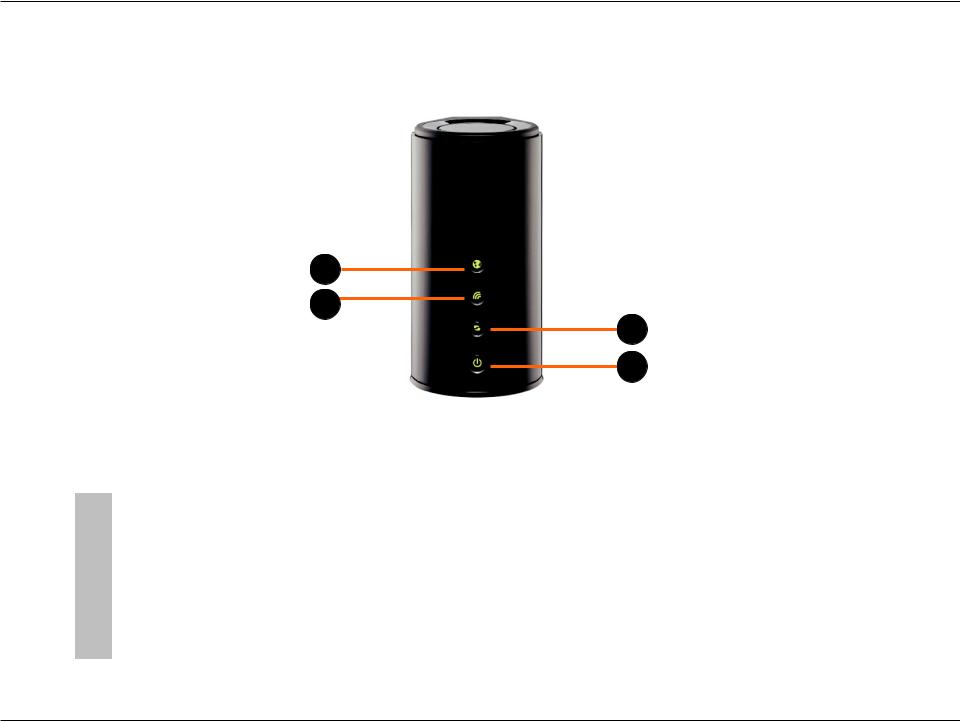
Section 1 - Product Overview
Hardware Overview
Front Panel
1
2
3
4
1 |
Internet Light |
A solid green light indicates that the Internet connection negotiation has successfully been completed. |
|
|
|
|
|
2 |
Wireless Light |
A solid green light indicates the device is ready to link up. |
|
|
|
|
|
3 |
|
Press the WPS button for 1 second to initiate the WPS process. The button will flash green while a |
|
WPSLightandButton |
WPS connection is being established. The button will light green for 5 seconds if a successful WPS |
||
|
|
connection has been made. |
|
|
|
|
|
4 |
Power Light Button |
Press the button to power on the device. The LED lights solid green to indicate the power is on. Press |
|
the button again to turn it off. |
|||
|
|
||
|
|
|
D-Link DIR-645 User Manual |
4 |

Section 1 - Product Overview
Back Panel
1
3
2
4
1 |
USB |
Use this port to connect a USB 2.0 printer or a Storage Device. |
|
|
|
2 |
Internet Port |
The Internet (WAN) port can be used for connections like a DSL/Cable modem. |
|
|
|
3 |
Ethernet Ports |
The four LAN ports can be used for 10/100/1000Mbps LAN connections. |
|
|
|
4 |
Power Receptor |
Receptor for the supplied power adapter. |
|
|
|
D-Link DIR-645 User Manual |
5 |

Section 1 - Product Overview
Bottom Panel
1
1 |
Reset Button |
Press the button to restore the device to its original factory default settings. |
|
|
|
D-Link DIR-645 User Manual |
6 |

Section 2 - Hardware Installation
Hardware Installation
This section will walk you through the installation process. Placement of the router is very important. Do not place the router in an enclosed area such as a closet, cabinet, attic or garage.
Before You Begin
•The router is designed for use with the Ethernet port on your broadband modem. If you were using the USB connection before using the router, you must turn off your modem and disconnect the USB cable. Connect an Ethernet cable to the WAN/Internet port on the router, and then turn the modem back on. In some cases, you may need to call your ISP to change your connection type (USB to Ethernet).
•If you have DSL and are connecting via PPPoE, be sure to disable or uninstall any PPPoE software such as WinPoet, Broadjump, or Enternet 300 from your computer. Otherwise you will not be able to connect to the Internet.
•When running the Setup Wizard from the D-Link CD, make sure your computer is connected to the Internet and is online, otherwise the wizard will not work. If you have disconnected any hardware, first re-connect your computer to the modem and make sure you are online.
D-Link DIR-645 User Manual |
7 |

Section 2 - Hardware Installation
Wireless Installation Considerations
The router lets you access your network using a wireless connection from virtually anywhere within the operating range of your wireless network. Keep in mind, however, that the number, thickness and location of walls, ceilings, or other objects that the wireless signals must pass through, may limit the range. Ranges vary depending on the types of materials and background RF (radio frequency) noise in your home or office. The key to maximizing the wireless range is to follow these basic guidelines:
1.Keep the number of walls and ceilings between the D-Link router and other network devices to a minimum. Each wall or ceiling can reduce your adapter’s range from 3 to 90 feet (1 to 30 meters.) Position your devices so that the number of walls and/or ceilings is minimized.
2.Be aware of the direct line between network devices. A wall that is 1.5 feet thick (0.5 meters), at a 45-degree angle appears to be almost 3 feet (1 meter) thick. At a 2-degree angle it looks over 42 feet (14 meters) thick. Position devices so that the signal will travel straight through a wall or ceiling (instead of at an angle) for better reception.
3.Try to position access points, wireless routers, and computers so that the signal passes through open doorways and drywall. Materials such as glass, metal, brick, insulation, concrete and water can affect wireless performance. Large objects such as fish tanks, mirrors, file cabinets, metal doors and aluminum studs may also have a negative effect on range.
4.Keep your product at least 3 to 6 feet (1-2 meters) away from electrical devices or appliances that generate RF noise.
5.If you are using 2.4GHz cordless phones, make sure that the 2.4GHz phone base is as far away from your wireless device as possible. The base transmits a signal even if the phone in not in use. In some cases, cordless phones, X-10 wireless devices, and electronic equipment such as ceiling fans, fluorescent lights, and home security systems may dramatically degrade wireless connectivity.
D-Link DIR-645 User Manual |
8 |

Section 2 - Hardware Installation
Connect to Cable/DSL/Satellite Modem
If you are connecting the router to a Cable/DSL/Satellite Modem, please follow the steps below:
1.Place the router in an open and central location. Do not plug the power adapter into the router.
2.Turn the power off on your modem. If there is no on/off switch, unplug the modem’s power adapter. Shut down your computer.
3.Unplug the Ethernet cable (that connects your computer to your modem) from your computer and place it into the Internet port on the router.
4.Plug an Ethernet cable into one of the LAN ports on the router. Plug the other end into the Ethernet port on your computer.
5.Turn on or plug in your modem. Wait for the modem to boot (about 30 seconds).
6.Plug the power adapter into the router and connect to an outlet or power strip. Wait about 30 seconds for the router to boot up.
7.Turn on your computer.
8.Verify that the Power LED on the router are lit. If the Power LED does not light up, make sure your computer, modem, and router are powered, on and verify that the cables connected correctly.
9.In a later section in this manual we’ll discuss the Web GUI configuration of the router in more detail..
D-Link DIR-645 User Manual |
9 |

Section 3 - Software Configuration
Configuration
This section will show you how to configure your new D-Link wireless router using the web-based configuration utility.
Web-based Configuration Utility
To access the configuration utility, open a web-browser such as Internet
Explorer and enter the IP address of the router (192.168.0.1).
You may also connect using the NetBIOS name in the address bar (http://dlinkrouter).
Select Admin from the drop-down menu and then enter your password.
The password is left blank by default.
If you get a Page Cannot be Displayed error, please refer to the
Troubleshooting section for assistance.
Log into the Router as follows:
•Select the ADMIN option from the drop-down menu and then enter your password. By default the password field is blank.
•Click the Login button to log into the Router.
D-Link DIR-645 User Manual |
10 |

Section 3 - Software Configuration
Setup Wizard
Internet Connection
Click Internet Connection Setup Wizard to quickly configure your router. Skip to the next page.
If you want to enter your settings without running the wizard, click
Manual Configuration and skip to page 20.
D-Link DIR-645 User Manual |
11 |
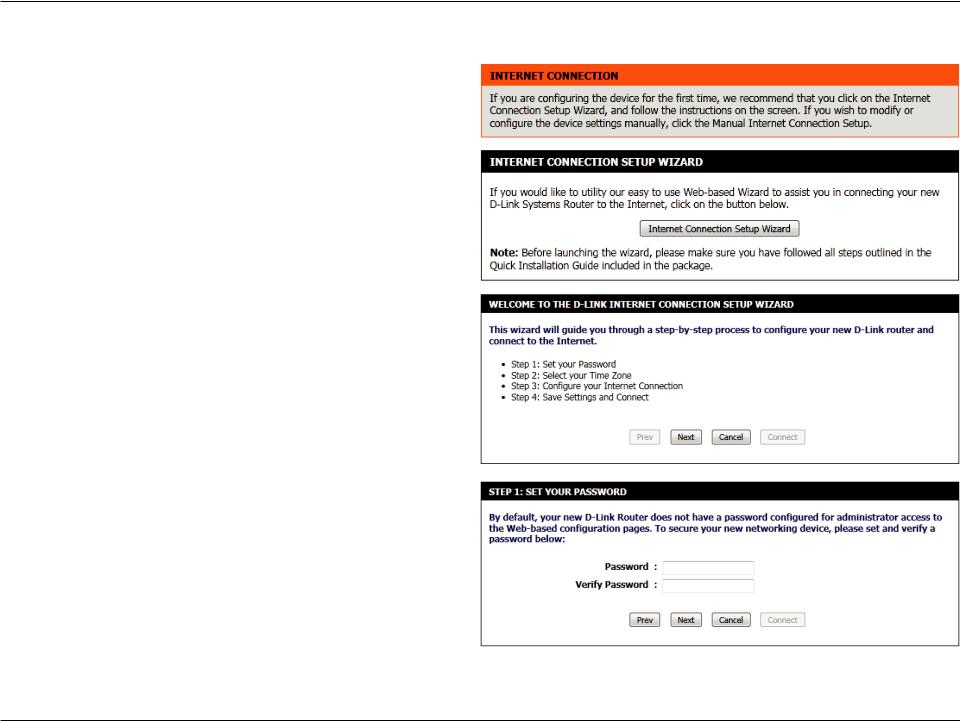
Section 3 - Software Configuration
Internet Connection(Setup Wizard)
When configuring the router for the first time, we recommend that you click use the Internet Connection Setup Wizard, and follow the instructions on the screen. This wizard is designed to assist user with a quick and easy method to configure the Internet Connectivity of this router.
Anytime during the Internet Connection Setup Wizard, the user can click on the Cancel button to discard any changes made and return to the main Internet page. Also the user can click on the Prev button, to return to the previous window for re-configuration.
This wizard will guide you through a step-by-step process to configure your new D-Link router and connect to the Internet.
Click Next to continue.
Step 1: Set Your Password
By default, the D-Link Router does not have a password configured for administrator access to the Web-based configuration pages. To secure your new networking device, please enter and verify a password in the spaces provided. The two passwords must match.
Click Next to continue.
D-Link DIR-645 User Manual |
12 |
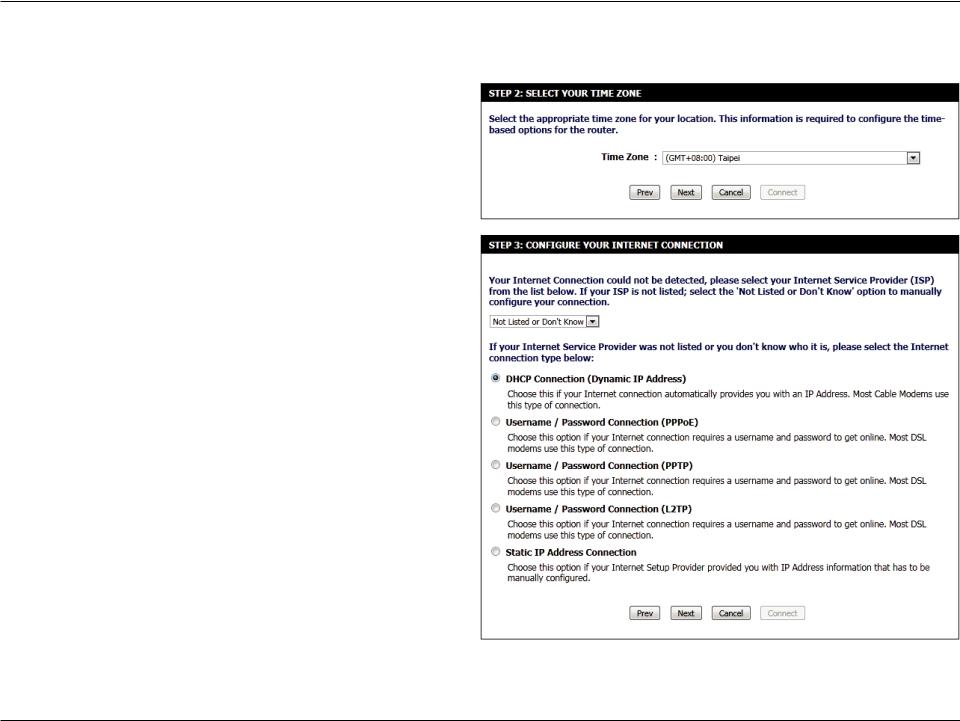
Section 3 - Software Configuration
Step 2: Select Your Time Zone
Select the appropriate time zone for your location. This information is required to configure the time-based options for the router.
Click Next to continue.
Step 3: Internet Connection
Here the user will be able to configure the Internet Connectivity used by this device. If your ISP connection is listed in the drop-down menu select it and click Next. If your ISP connection is not listed then you can proceed to select any of the other manual Internet Connection methods listed below.
Dynamic IP Choose this if your Internet connection Address: automatically provides you with an IP Address.
Most Cable Modems use this type of connection.
PPPoE: Choose this option if your Internet connection requires a PPPoE username and password to get online. Most DSL modems use this type of connection.
PPTP: Choose this option if your Internet connection requires a PPTP username and password to get online.
L2TP: Choose this option if your Internet connection requires an L2TP username and password to get online.
Static IP Address: Choose this option if your Internet Setup Provider provided you with IP Address information that has to be manually configured.
D-Link DIR-645 User Manual |
13 |
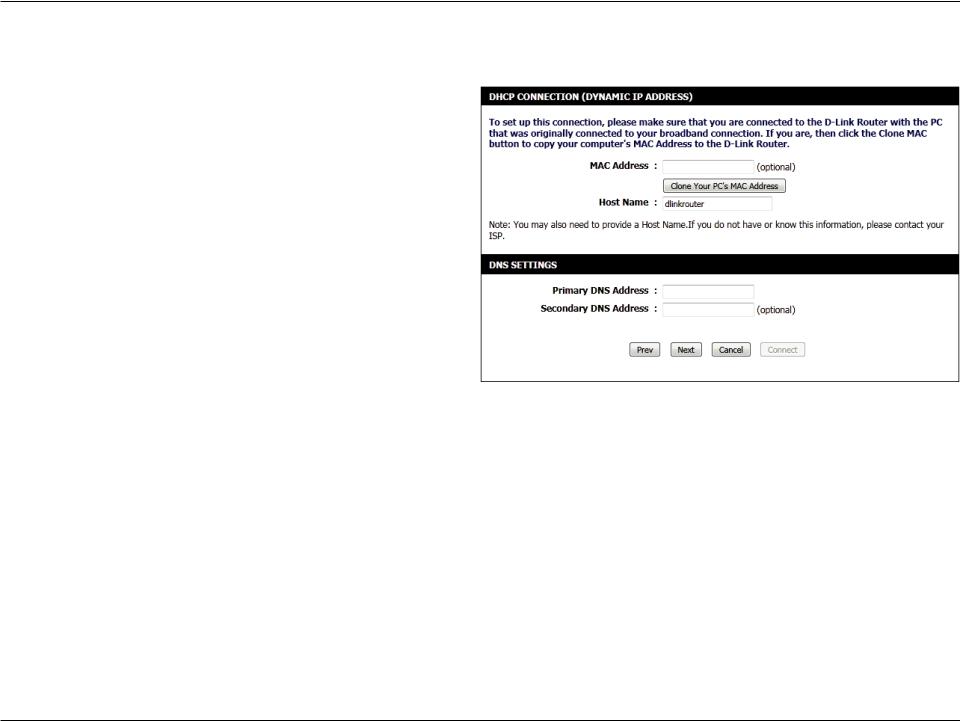
Section 3 - Software Configuration
Step 3: Internet Connection (Dynamic IP Address)
After selecting the Dynamic IP Address Internet connection method, the following page will appear.
MAC Address: Enter the MAC address of the Internet gateway (plugged into the Internet port of this device) here.
Clone Button: If the configuration PC also acts as the Internet gateway, then click on the Clone Your PC’s MAC Address button to copy the PC’s MAC address into the space provided. If you’re not sure, leave the MAC Address field blank.
Host Name: Enter the host name used here. You may also need to provide a Host Name. If you do not have or know this information, please contact your ISP.
Primary DNS Enter the Primary DNS IP address used here.
Address:
Secondary DNS Enter the Secondary DNS IP address used here. This field is normally optional. Only one DNS address is required for a functional Address: Internet connection, but using a second DNS address provides more stability.
Click Next to continue.
D-Link DIR-645 User Manual |
14 |
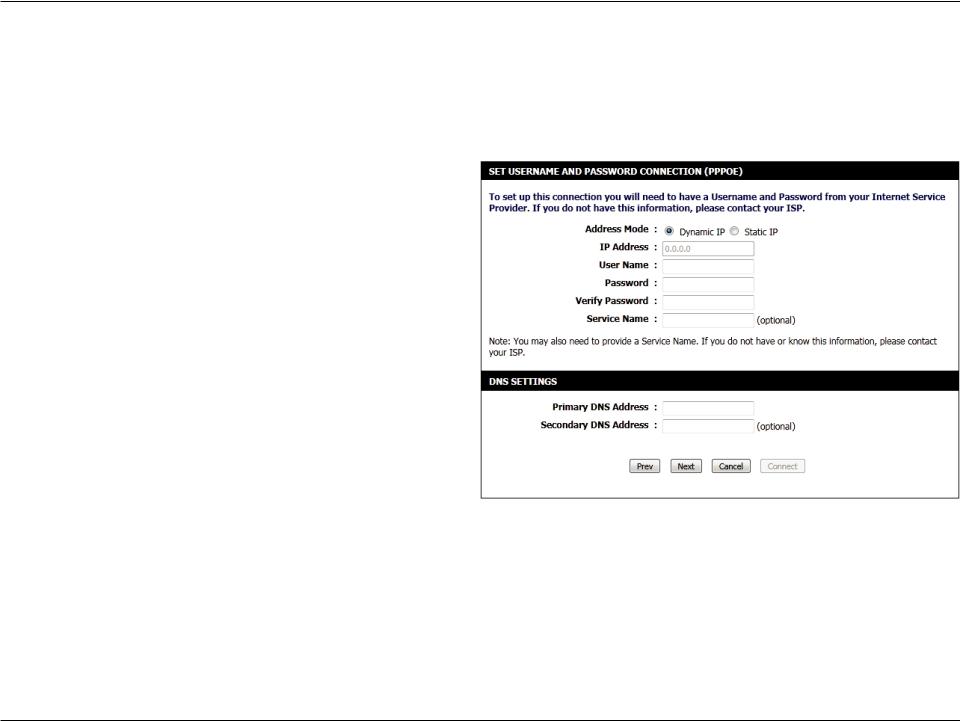
Section 3 - Software Configuration
Step 3: Internet Connection (PPPoE)
After selecting the PPPoE Internet connection method, the following page will appear:
Address Mode: Here the user can specify whether this Internet connection requires the use of a Dynamic or Static IP address. PPPoE usually requires a Dynamic IP configuration.
IP Address: Enter the PPPoE IP address used here. This option is only available if Static IP is selected.
User Name: Enter the PPPoE account user name used here. This information is given by the ISP.
Password: Enter the PPPoE account password used here. This information is given by the ISP.
Verify Password: Re-enter the PPPoE account password used here.
Service Name: This optional field enables the user to enter a service name to identify this Internet connection here.
Primary DNS Enter the Primary DNS IP address used here.
Address:
Click Next to continue.
D-Link DIR-645 User Manual |
15 |
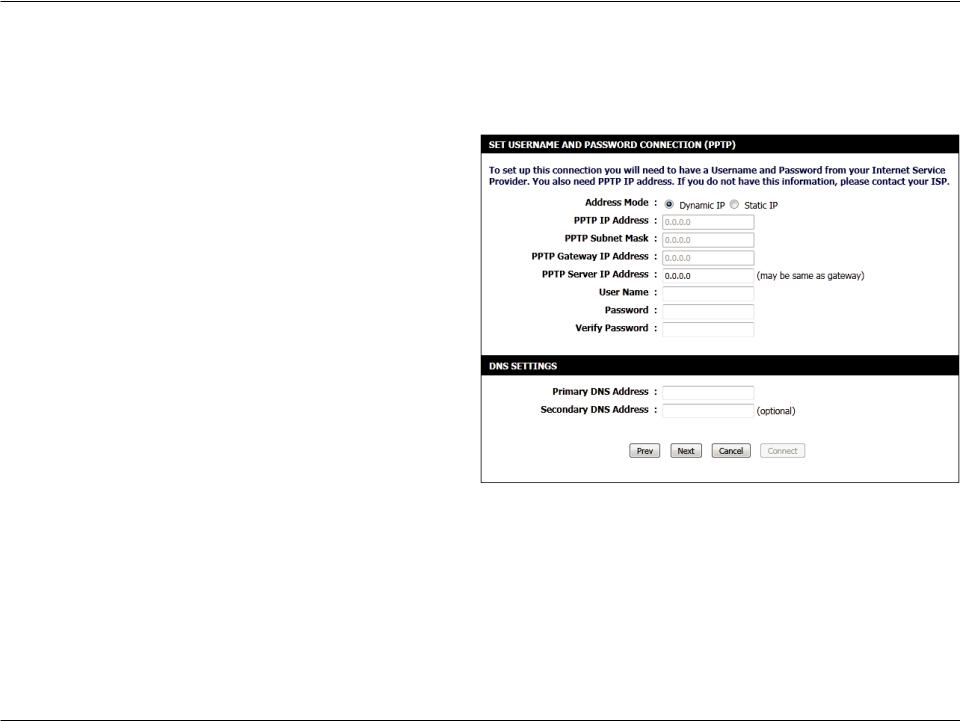
Section 3 - Software Configuration
Step 3: Internet Connection (PPTP)
After selecting the PPTP Internet connection method, the following page will appear:
Address Mode: Here the user can specify whether this Internet connection requires the use of a Dynamic or Static IP address. PPTP usual requires a Dynamic IP configuration.
PPTP IP Address: Enter the PPTP IP address used here. This option is only available if Static IP is selected.
PPTP Subnet Enter the PPTP Subnet Mask used here.
Mask:
PPTP Gateway IP Enter the PPTP Gateway IP address used here.
Address:
PPTP Server IP Enter the PPTP Server IP address used here. This is Address: normally the same a the PPTP Gateway IP address.
User Name: Enter the PPTP username used here. Password: Enter the PPTP password used here.
Verify Password: Re-enter the PPTP password used here.
Primary DNS Enter the Primary DNS IP address used here.
Address:
Secondary DNS Enter the Secondary DNS IP address used here. This field is normally optional. Only one DNS address is required for a functional Address: Internet connection, but using a second DNS address provides more stability.
Click Next to continue.
D-Link DIR-645 User Manual |
16 |
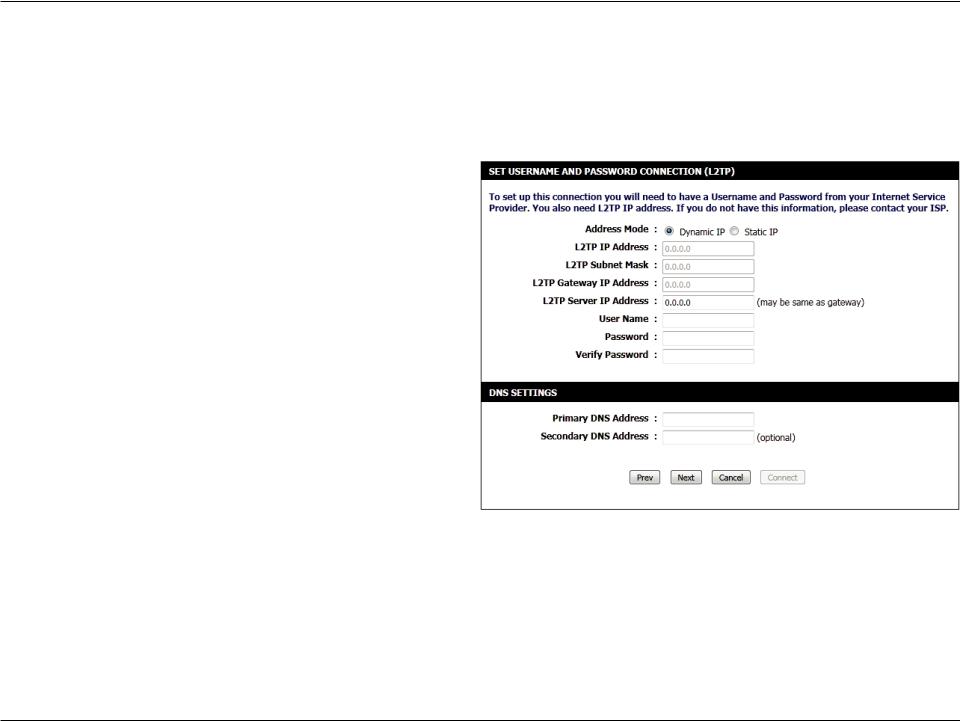
Section 3 - Software Configuration
Step 3: Internet Connection (L2TP)
After selecting the L2TP Internet connection method, the following page will appear:
Address Mode: Here the user can specify whether this Internet connection requires the use of a Dynamic or Static IP address. L2TP usual requires a Dynamic IP configuration.
L2TP IP Address: Enter the L2TP IP address used here. This option is only available if Static IP is selected.
L2TP Subnet Enter the L2TP Subnet Mask used here.
Mask:
L2TP Gateway IP Enter the L2TP Gateway IP address used here.
Address:
L2TP Server IP Enter the L2TP Server IP address used here. This is Address: normally the same a the L2TP Gateway IP address.
User Name: Enter the L2TP username used here. Password: Enter the L2TP password used here.
Verify Password: Re-enter the L2TP password used here.
Primary DNS Enter the Primary DNS IP address used here.
Address:
Secondary DNS Enter the Secondary DNS IP address used here. This field is normally optional. Only one DNS address is required for a functional Address: Internet connection, but using a second DNS address provides more stability.
Click Next to continue.
D-Link DIR-645 User Manual |
17 |

Section 3 - Software Configuration
Step 3: Internet Connection (Static IP Address)
After selecting the Static IP Address Internet connection method, the following page will appear:
IP Address: Enter the Static IP address provided by the ISP here.
Subnet Mask: Enter the Subnet Mask provided by the ISP here.
Gateway Enter the Gateway IP address provided by the ISP
Address: here.
Primary DNS Enter the Primary DNS IP address used here.
Address:
Secondary DNS Enter the Secondary DNS IP address used here.This Address: field is normally optional. Only one DNS address is required for a functional Internet connection, but using a second DNS address provides more
stability.
Click Next to continue.
Setup Complete!
This is the last page of the Internet Connection Setup Wizard.
Click the Connect button to save your settings.
D-Link DIR-645 User Manual |
18 |
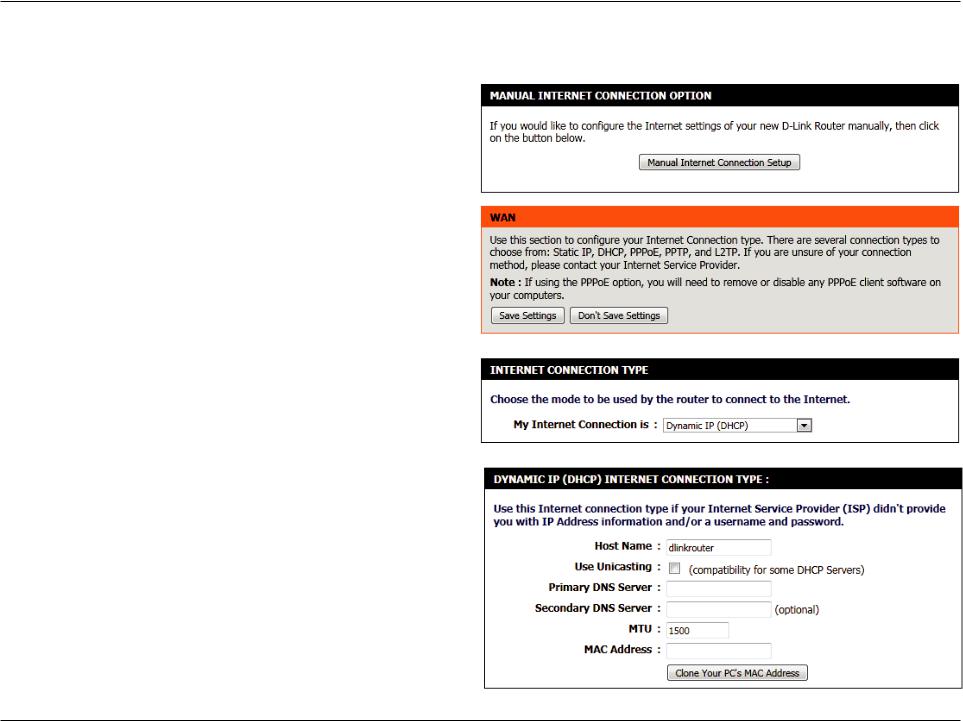
Section 3 - Software Configuration
Manual Configuration
On this page the user can configure the Internet Connection settings manually. To access the Manual Internet Connection Setup page, click on the Manual Internet Connection Setup button. On this page there a multiple parameters that can be configured regarding the Internet Connection setup. We’ll discuss them from top to bottom.
At any given point the user can save the configuration done by clicking on the Save Settings button. If you choose to discard the changes made, click on the Don’t Save Settings button.
Internet Connection Type
In this section, the user can select from a list of Internet Connection types that can be configured and used on this router. Options to choose from are Static IP, Dynamic IP, PPPoE, PPTP, L2TP, and DS-Lite.
After selecting a specific Internet Connection type, this page will automatically refresh and provide unique fields to configure related to the specified Internet Connection type.
My Internet Connection is: Dynamic IP (DHCP)
The default WAN configuration for this router is Dynamic IP (DHCP). This option allows the router to obtain an IP address automatically from the device that is connected to the Internet port.
Note: If you’re not sure about the type of Internet Connection you have, please contact your Internet Service Provider (ISP) for assistance.
Host Name: The Host Name is optional but may be required by some ISPs. Leave blank if you are not sure.
Use Unicasting: Tick this option if you ISP uses the unicast method to provide IP addresses.
Primary DNS: Enter the Primary DNS IP address used here.
D-Link DIR-645 User Manual |
19 |

Section 3 - Software Configuration
Secondary DNS: Enter the Secondary DNS IP address used here. This field is normally optional. Only one DNS address is required for a functional Internet connection, but using a second DNS address provides more stability.
MTU: Maximum Transmission Unit - you may need to change the MTU for optimal performance with your specific ISP. 1500 is the default MTU.
MAC Address: The default MAC Address is set to the Internet port’s physical interface MAC address on the Broadband Router. It is not recommended that you change the default MAC address unless required by your ISP. You can use the Clone Your PC’s MAC Address button to replace the Internet port’s MAC address with the MAC address of your Ethernet card.
My Internet Connection is: Static IP
Another Internet Connection type is Static IP. This option allows the user to manually configure the Static IP Internet Connection type. Normally the information entered will be supplied by your ISP.
IP Address: Enter the Static IP address provided by the ISP here.
Subnet Mask: Enter the Subnet Mask provided by the ISP here.
Default Enter the Gateway IP address provided by the ISP
Gateway: here.
Primary DNS: Enter the Primary DNS IP address used here.
Secondary DNS: Enter the Secondary DNS IP address used here.This field is normally optional. Only one DNS address is required for a functional Internet connection, but using a second DNS address provides more stability.
MTU: Maximum Transmission Unit - you may need to change the MTU for optimal performance with your specific ISP. 1500 is the default MTU.
MAC Address: The default MAC Address is set to the Internet port’s physical interface MAC address on the Broadband Router. It is not recommended that you change the default MAC address unless required by your ISP. You can use the Clone Your PC’s MAC Address button to replace the Internet port’s MAC address with the MAC address of your Ethernet card.
D-Link DIR-645 User Manual |
20 |

Section 3 - Software Configuration
My Internet Connection is: PPPoE (Username/Password)
Another Internet Connection type is PPPoE. This option is typically used if you have a DSL Internet Connection. Make sure to remove the PPPoE software installed on your computer first before using this connection type. Most of the information needed for this connection type is provided to you by your ISP.
Address Mode: Here the user can specify whether this Internet connection requires the use of a Dynamic or Static IP address. PPPoE usually requires a Dynamic IP configuration.
IP Address: Enter the PPPoE IP address used here. This option is only available if Static IP is selected.
Username: Enter the PPPoE account user name used here. This information is given by the ISP.
Password: Enter the PPPoE account password used here. This information is given by the ISP.
Verify Password: Re-enter the PPPoE account password used here.
Service Name: This optional field enables the user to enter a service name to identify this Internet connection here.
Reconnect Use the radio buttons to specify the reconnect Mode: mode. The user can specify a custom schedule or specify the On Demand, or Manual option. To specify a custom schedule, use the drop-down menu to select one of the schedules that has been defined in the Schedules page. To create a new schedule, click the New Schedule button to open the Schedules page. Schedules will be discussed
later.
Maximum Idle Enter a maximum idle time during which the Internet connection is maintained during inactivity.
Time:
DNS Mode: This option allow the router to obtain the DNS IP addresses from the ISP, when Receive DNS from ISP is selected, or allows the user to enter DNS IP address manually, when Enter DNS Manually is selected.
Primary DNS Enter the Primary DNS IP address used here.
Server:
D-Link DIR-645 User Manual |
21 |

Section 3 - Software Configuration
Secondary DNS Enter the Secondary DNS IP address used here. This field is normally optional. Only one DNS address is required for a functional Server: Internet connection, but using a second DNS address provides more stability.
MTU: Maximum Transmission Unit - you may need to change the MTU for optimal performance with your specific ISP. 1492 is the default MTU.
MAC Address: The default MAC Address is set to the Internet port’s physical interface MAC address on the Broadband Router. It is not recommended that you change the default MAC address unless required by your ISP. You can use the Clone Your PC’s MAC Address button to replace the Internet port’s MAC address with the MAC address of your Ethernet card.
D-Link DIR-645 User Manual |
22 |
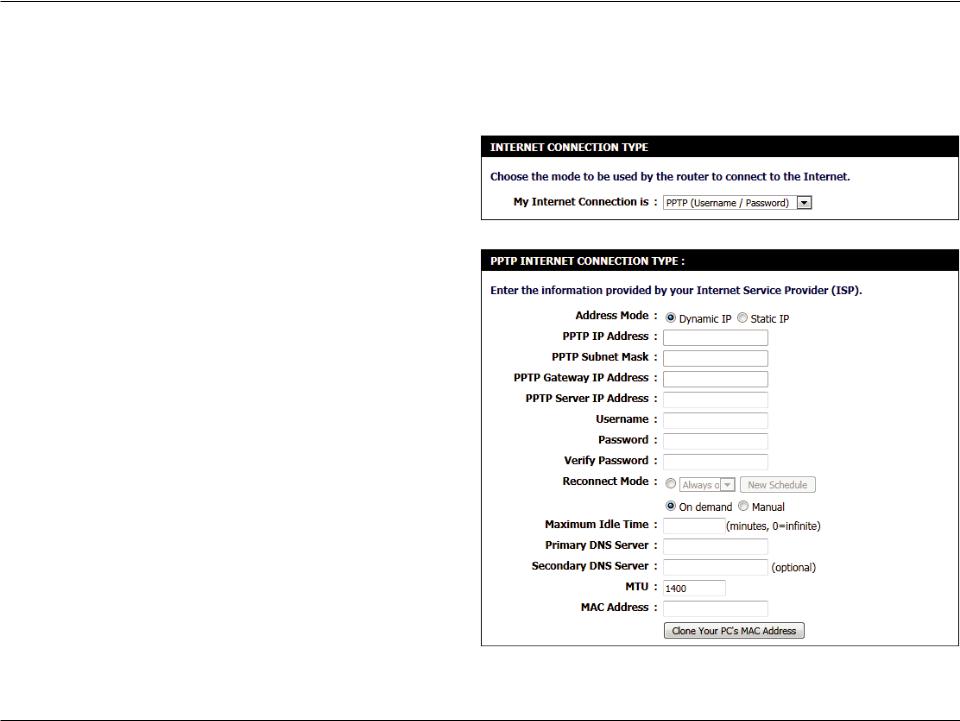
Section 3 - Software Configuration
My Internet Connection is: PPTP (Username/Password)
Another Internet Connection type is PPTP. This option is typically used if you have a secure DSL Internet Connection. Most of the information needed for this connection type is provided to you by your ISP.
Address Mode: Here the user can specify whether this Internet connection requires the use of a Dynamic or Static IP address. PPTP usually requires a Dynamic IP configuration.
PPTP IP Address: Enter the PPTP IP address used here. This option is only available if Static IP is selected.
PPTP Subnet Enter the PPTP Subnet Mask used here.
Mask:
PPTP Gateway IP Enter the PPTP Gateway IP address used here.
Address:
PPTP Server IP Enter the PPTP Server IP address used here. This is Address: normally the same a the PPTP Gateway IP address.
Username: Enter the PPTP username used here. Password: Enter the PPTP password used here.
Verify Password: Re-enter the PPTP password used here.
Reconnect Use the radio buttons to specify the reconnect Mode: mode. The user can specify a custom schedule or specify the On Demand, or Manual option. To specify a custom schedule, use the drop-down menu to select one of the schedules that has been defined in the Schedules page. To create a new schedule, click the New Schedule button to open the Schedules page. Schedules will be discussed
later.
D-Link DIR-645 User Manual |
23 |
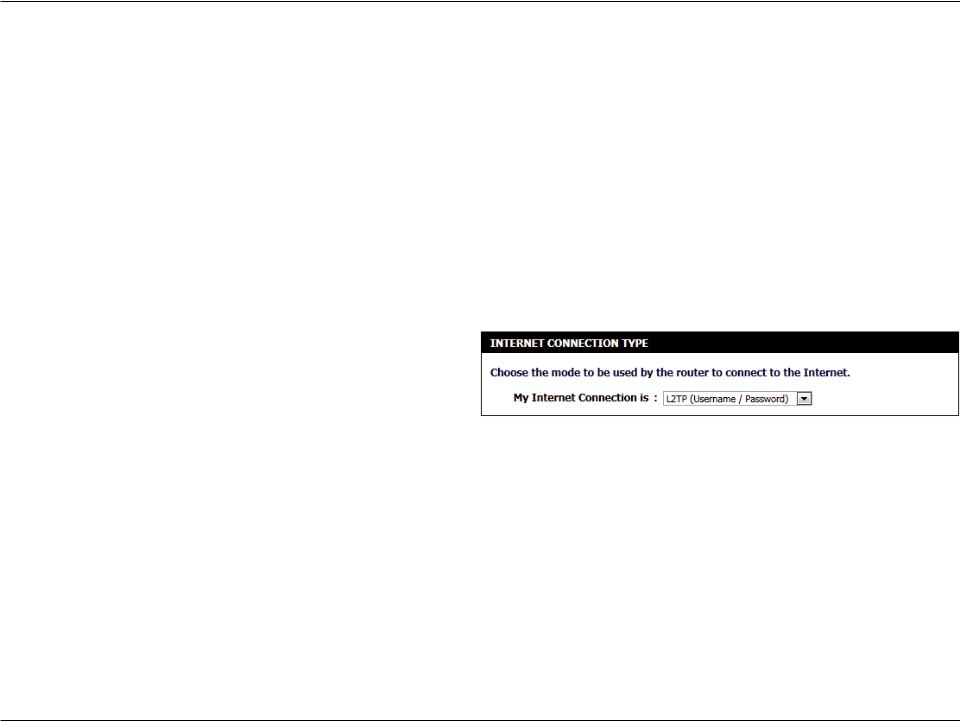
Section 3 - Software Configuration
Maximum Idle Enter a maximum idle time during which the Internet connection is maintained during inactivity. To disable this feature, Time: enable Auto-reconnect.
Primary DNS Enter the Primary DNS IP address used here.
Server:
Secondary DNS Enter the Secondary DNS IP address used here. This field is normally optional. Only one DNS address is required for a functional Server: Internet connection, but using a second DNS address provides more stability.
MTU: Maximum Transmission Unit - you may need to change the MTU for optimal performance with your specific ISP. 1400 is the default MTU.
MAC Address: The default MAC Address is set to the Internet port’s physical interface MAC address on the Broadband Router. It is not recommended that you change the default MAC address unless required by your ISP. You can use the Clone Your PC’s MAC Address button to replace the Internet port’s MAC address with the MAC address of your Ethernet card.
My Internet Connection is: L2TP (Username/Password)
Another Internet Connection type is L2TP. This option is typically used if you have a secure DSL Internet Connection. Most of the information needed for this connection type is provided to you by your ISP.
D-Link DIR-645 User Manual |
24 |

Section 3 - Software Configuration
Address Mode: Here the user can specify whether this Internet connection requires the use of a Dynamic or Static IP address. L2TP usual requires a Dynamic IP configuration.
L2TP IP Address: Enter the L2TP IP address used here. This option is only available if Static IP is selected.
L2TP Subnet Enter the L2TP Subnet Mask used here.
Mask:
L2TP Gateway IP Enter the L2TP Gateway IP address used here.
Address:
L2TP Server IP Enter the L2TP Server IP address used here. This is Address: normally the same a the L2TP Gateway IP address.
Username: Enter the L2TP username used here. Password: Enter the L2TP password used here.
Verify Password: Re-enter the L2TP password used here.
Reconnect Use the radio buttons to specify the reconnect Mode: mode. The user can specify a custom schedule or specify the On Demand, or Manual option. To specify a custom schedule, use the drop-down menu to select one of the schedules that has been defined in the Schedules page. To create a new schedule, click the New Schedule button to open the Schedules page. Schedules will be discussed
later.
Maximum Idle Enter a maximum idle time during which the Internet connection is maintained during inactivity. To disable this feature, Time: enable Auto-reconnect.
Primary DNS Enter the Primary DNS IP address used here.
Server:
Secondary DNS Enter the Secondary DNS IP address used here. This field is normally optional. Only one DNS address is required for a functional Server: Internet connection, but using a second DNS address provides more stability.
D-Link DIR-645 User Manual |
25 |

Section 3 - Software Configuration
MTU: Maximum Transmission Unit - you may need to change the MTU for optimal performance with your specific ISP. 1400 is the default MTU.
MAC Address: The default MAC Address is set to the Internet port’s physical interface MAC address on the Broadband Router. It is not recommended that you change the default MAC address unless required by your ISP. You can use the Clone Your PC’s MAC Address button to replace the Internet port’s MAC address with the MAC address of your Ethernet card.
D-Link DIR-645 User Manual |
26 |
